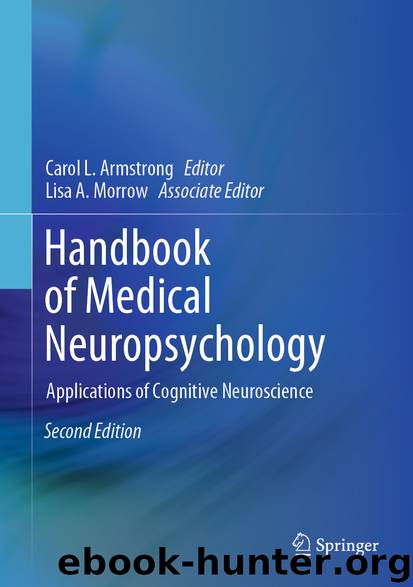Handbook of Medical Neuropsychology by Unknown

Author:Unknown
Language: eng
Format: epub
ISBN: 9783030148959
Publisher: Springer International Publishing
Inhibitory Deficit Hypothesis
In addition to processing speed, research suggests that older adults may manifest inhibitory deficits in working memory. Hasher and Zacks [45] proposed the inhibitory deficit framework, which suggests that an efficient (fast and accurate) mental life requires the ability to limit activation to information most relevant to one’s goals. Three functions of inhibition were proposed: controlling access to attention’s focus, deleting irrelevant information from attention and working memory, and suppressing or restraining strong but inappropriate responses. The inhibitory deficit hypothesis has generally been supported by findings from a variety of experimental paradigms, including negative priming [46, 47], text processing [48], and speech production [49]. Further, evidence from experimental tasks demonstrates that the PFC is particularly important for efficient inhibitory processes in working memory [50, 51].
A central component of the concepts of access, deletion, and suppression or restraining is the notion of cognitive control in working memory. Thus, when discussing the inhibitory deficit hypothesis of cognitive aging, we must also understand how and why working memory is affected. Working memory can be conceptualized in two important ways: (1) as the amount of online cognitive resources available at any given moment to process information and (2) as the amount of mental energy available to perform online mental operations [52]. In other words, working memory allows humans (and other species) to maintain a limited amount of information in an active state for a brief period of time and to manipulate that information [52]. Thus, the online manipulation of material may be a cornerstone of higher cognitive processes, such as reasoning, decision-making, problem-solving, and language understanding (e.g., [53, 54]).
We typically measure working memory by asking participants to both store and process information simultaneously. An example of a common working memory task would be constructing a “mental map” of an area while receiving directions on how to find a particular house there. Typically, the amount of information kept active, or “online,” ranges from 1 to 10 items whereas the duration of that storage ranges from 0 to 60 s. Changes in working memory are tied to cognitive aging and can be examined through both a capacity metaphor (amount of resources) and an energy metaphor (processing resources). Regardless of the metaphor, as it relates to age-related decline, cognitive functioning will depend on the resources of the individuals involved and, critically, on the demands made by the subcomponents of the task. When those demands are minimal, age deficits should also be minimal [55]. However, age deficits should increase as the cognitive demands of the task increase [45].
The inhibitory deficit hypothesis employs the capacity metaphor and assumes that success in active mental processing (mediated by working memory) may require the inhibition of irrelevant information. An inhibitory mechanism may serve to limit entrance into working memory only to information that is along the “goal path” of comprehension. That is, the inhibitory mechanism may act to suppress or delete irrelevant information from working memory. Older adults however may be less likely to inhibit such unwanted thoughts as compared to younger adults.
Download
This site does not store any files on its server. We only index and link to content provided by other sites. Please contact the content providers to delete copyright contents if any and email us, we'll remove relevant links or contents immediately.
Adulting by Kelly Williams Brown(3671)
Figure Drawing for Artists by Steve Huston(2799)
Draw Your Day by Samantha Dion Baker(2708)
Drawing Cutting Edge Anatomy by Christopher Hart(2678)
Drawing Shortcuts: Developing Quick Drawing Skills Using Today's Technology by Leggitt Jim(2532)
Make Comics Like the Pros by Greg Pak(2423)
Draw to Win: A Crash Course on How to Lead, Sell, and Innovate With Your Visual Mind by Dan Roam(2277)
How Proust Can Change Your Life by Alain De Botton(2261)
Day by Elie Wiesel(2243)
0041152001443424520 .pdf by Unknown(2220)
How The Mind Works by Steven Pinker(2214)
Rapid Viz: A New Method for the Rapid Visualization of Ideas by Kurt Hanks & Larry Belliston(2195)
Modern Cartooning by Christopher Hart(2189)
Poses for Artists Volume 2 - Standing Poses: An essential reference for figure drawing and the human form. (Inspiring Art and Artists) by Justin Martin(2145)
Draw-A-Saurus by James Silvani(2105)
Learn Drawing Quickly by Sharon Finmark(2090)
Tattoo Art by Doralba Picerno(2083)
Poses for Artists - Dynamic & Sitting: An essential reference for figure drawing and the human form (Inspiring Art and Artists Book 1) by Justin R Martin(2063)
Drawing and Painting Birds by Tim Wootton(2001)
